Air Operations, Carolines 8 30th Heavy Bomb Group B-24s attack the Yap Atoll.
[  | |   ] ]
Air Operations, CBI
BURMA
- 5 10th Air Force B-25s attack rail facilities and a motor pool at Kyaukme.
- 2 B-25s attack a motor pool at Namhsim.
- 1 B-25 attacks a rail line at Nawngpeng.
- 20 10th Air Force P-47s attack Japanese Army troops at Kyungyi and Nanhlaing.
- 16 P-47s support Allied ground forces around Henu and Mawlu.
- 7 P-47s attack a bridge at Panghkam.
- 4 P-47s attack a bivouac at Indaw.
CHINA
- 6 341st Medium Bomb Group B-25s and 11 14th Air Force P-51s attack Mengshu.
- 3 B-25s attack a bridge at Lohochai.
- More than 50 P-51s and P-40s attack occupied towns in the Mengshu area.
- More than 40 P-51s and P-40s attack various targets in east-central and southern China.
[  | |   ] ]
Air Operations, East Indies - FEAF B-24s and P-38s attack shipping around Makassar, Celebes.
- B-25s, A-20s, and fighter-bombers attack the town area at Amboina Town, oil stores at Boela, Ceram, and two airfields and targets of opportunity on Amboina, Boroe, and Ceram.
- Fighter-bombers attack Japanese Army bivouacs across Halmahera.
- 347th Fighter Group P-38s down 6 Japanese Army fighters near the Boeloedowang airfield on Celbes between 1010 and 1040 hours.
[  | |   ] ]
Air Operations, Europe
RAF BOMBER COMMAND
Daylight Ops:
- 112 Lancasters of No. 5 Group attack the Flushing battery positions, but visibility is poor and the bombing is scattered.
Minor Ops:
- There are 6 Ranger patrols and 4 RCM sorties.
Evening Ops:
- 1,055 aircraft including 561 Lancasters, 463 Halifaxes,and 31 Mosquitos, are sent to Essen. This is the heaviest raid on this target so far in the war and the number of aircraft sent is also the greatest number to any target to this point. These new records are achieved without the Lancasters of No. 5 Group being included. 4,538 tons of bombs are dropped. More than 90 per cent of this tonnage is high explosive including 509 4,000-pounders because it is now considered that most of the burnable buildings in Essen have been destroyed in earlier raids.
The greater proportion of high explosive, against all the trends in earlier area-bombing raids, is now quite common in attacks on targets which have suffered major fire damage in 1943. However, incendiaries start fires in vast slag heaps, which are still smouldering in the late 1940s.
- 5 Lancasters and 3 Halifaxes are lost.
Minor Ops:
- 38 Mosquitos are sent to Berlin, 10 to Wiesbaden and 2 to Aschaffenburg, 1 Hudson is on a Resistance operation, and there are 50 Mosquito patrols and 41 RCM sorties.
US 12th AIR FORCE
ITALY:
- Some XXII TAC P-47s are able to attack many locomotives, rail cars, motor vehicle, and vessels around Genoa, Padua, Savona, and Turin.
- During the night, XXII TAC A-20s attack targets of opportunity in the Po River valley.
US 15th AIR FORCE
CZECHOSLOVAKIA:
- 15th Air Force B-17s attack the Skoda arms complex at Pilsen.
GERMANY:
- 15th Air Force B-24s attack an arms factory at Plauen, and a marshalling yard and oil-industry targets at Regensburg.
- 15th Air Force B-17s attack a mashalling yard at Rosenheim.
ITALY:
- 15th Air Force attack rail lines around Brenner Pass and throughout northern Italy.
[  | |   ] ]
Air Operations, Japan In the Kurile Islands, 5 28th Composite Group B-25s attack the Asahi Bay area, 3 B-24s attack Kashiwabara, and 3 B-24s attack Otomari.
[  | |   ] ]
Air Operations, New Guinea - V Bomber Command A-20s support Allied ground forces along the Orai and Sawar rivers.
- V Fighter Command fighter-bombers attack Sagan.
[  | |   ] ]
Air Operations, Philippines - FEAF B-25s attack shipping in the Sulu Archipelago.
- Task Group 77.4 carrier aircraft support US 6th Army ground forces on Leyte.
- 2 VF-35 F6Fs down a D3A 'Val' dive bomer near Leyte at 0605 hours.
[  | |   ] ]
Battle of Leyte Gulf Kurita's Center Force is sighted off Palawan in the early hours by 2 US submarines. 2 heavy cruisers, the Atago and the Maya, are sunk in the subsequent attacks by US submarines Dace (SS-247) and Darter (SS-227), and one more is damaged and forced to retire. One of the submarines is lost but because of their reports the 3 remaining groups of TF 38 east of the Philippines prepare to attack when the Japanese squadron is in range.
[ | |   ] ]
Diplomatic Relations (22?) Britain, the United States and the Soviet Union recognize de Gaulle's administration as the Provisional Government of France.
[  | |   ] ]
Eastern Front In the far north the Russians complete the clearance of the Petsamo region. The Russians now hold a 137-km front in East Prussia.
SOUTHERN SECTOR
The III Panzer Corps is redeployed into Hungary and commits to protect the rear of the 8th Army. The XVII and XXIX Corps are fighting west to avoid encirclement east of Nyireghaza.
[  | |   ] ]
Germany, Home Front The German news bureau reports vast numbers of volunteers flocking to joint he Volkssturm territorial army, including boys and men younger and older than the specified age groups.
[  | |   ] ]
Italy In the western sector the position of the Allied divisions remains substantially unchanged. The 5th Army captures Monte Salvaro. In the east, where the units of the British 8th Army are operating, the bridgeheads over the Savio River are reinforced.
[  | |   ] ]
Pacific - The US submarine Croaker (SS-246) sinks the Japanese merchant cargo ship Hakuran Maru (887t) in the Yellow Sea off the west coast of Korea.
- The US submarine Sawfish (SS-276) sinks the Japanese seaplane carrier Kimikawa Maru (6863t) west of Luzon.
- The US submarine Tang (SS-306) sinks Japanese cargo ships Toun Maru (1915t) and Tatsuju Maru (1944t) (1944t) and transport Wakatake Maru (1920t) and merchant cargo ship Kori Go in Formosa Strait.
[  | |   ] ]
Philippines The battles on Leyte continue. In a solemn ceremony at Tacloban, MacArthur re-installs the legitimate government of the Philippines under the presidency of Sergio Osmena.
North of Tacloban the 1st Cav Div exerts powerful pressure against part of the Japanese 16th Div to drive them out the northwest part of the island and liberate the San Juanico Strait, between Leyte and the neighboring island of Samar, so as to hinder enemy moverment between the 2 islands.
In the southern sector, where the US XXIV Corps is in action, the 96th Inf Div is short of supplies. The 7th Div, supported by a tank battalion, continues to advance inland toward Burauen, near to which are San Pablo airport and other landing grounds. The tanks get as far as Burauen; the infantry occupy Julita and San Pablo and take the airport.
Adm Onishi, CinC Japanese Naval Air Fleet, forms the Kamikaze corps from 210 Air Wing stationed at Clark Field, south of Manila.
[  | |   ] ]
Western Front On the left flank of the British I Corps, the 4th Arm Div moves off westward toward Bergen-op-Zoom, to close off the isthmus of South Beveland, along which the Canadian 2nd Div is preparing to advance.
The advance toward St Dié by the 3rd Div, VI Corps, is effectively opposed by units of Friedrich von Wiese's German 19th Army. On the right flank of the VI Corps, the US 36th Div is advancing east of Bruyéres toward Biffantoaine.
[  | |   ] ]
Images from October 23, 1944
Moving Toward Nuland
|
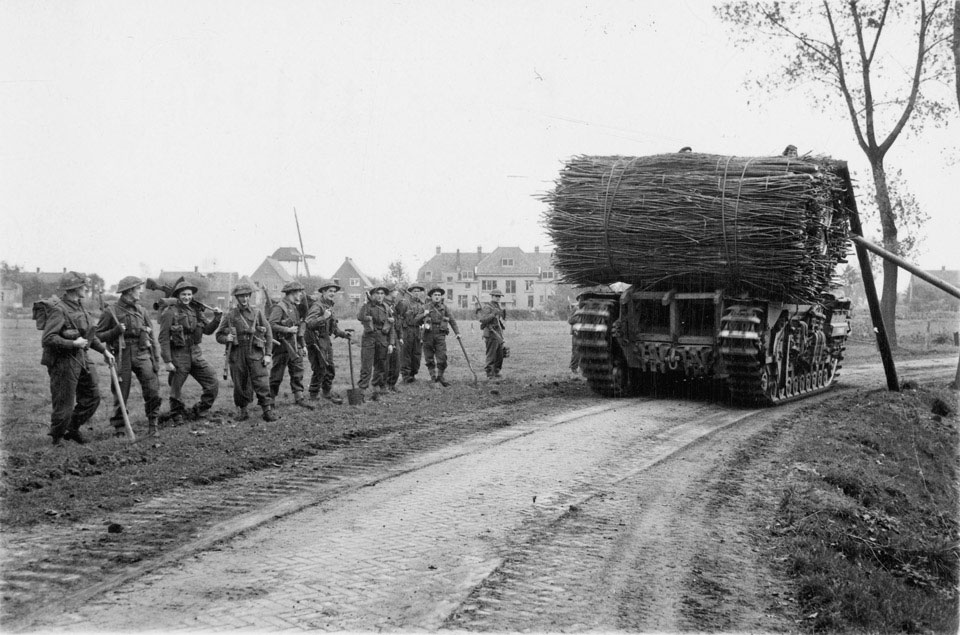 |
|
British Infantry Outside Heike
|
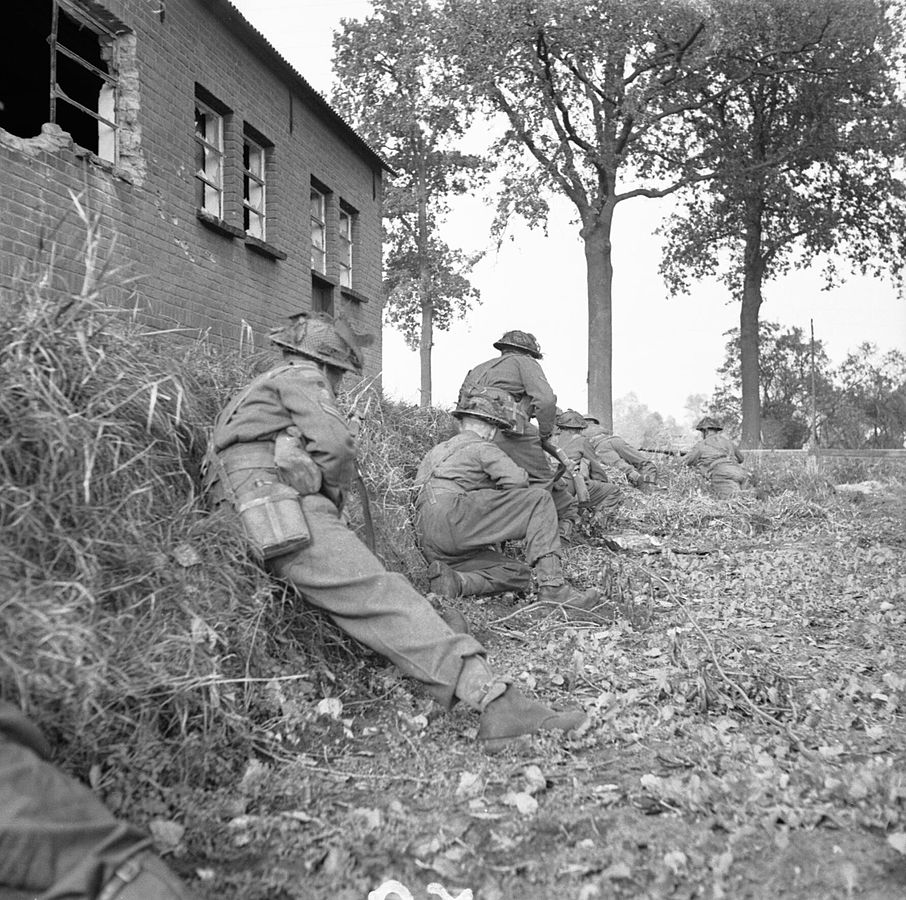 |
|
Partisans in Belgrade
|
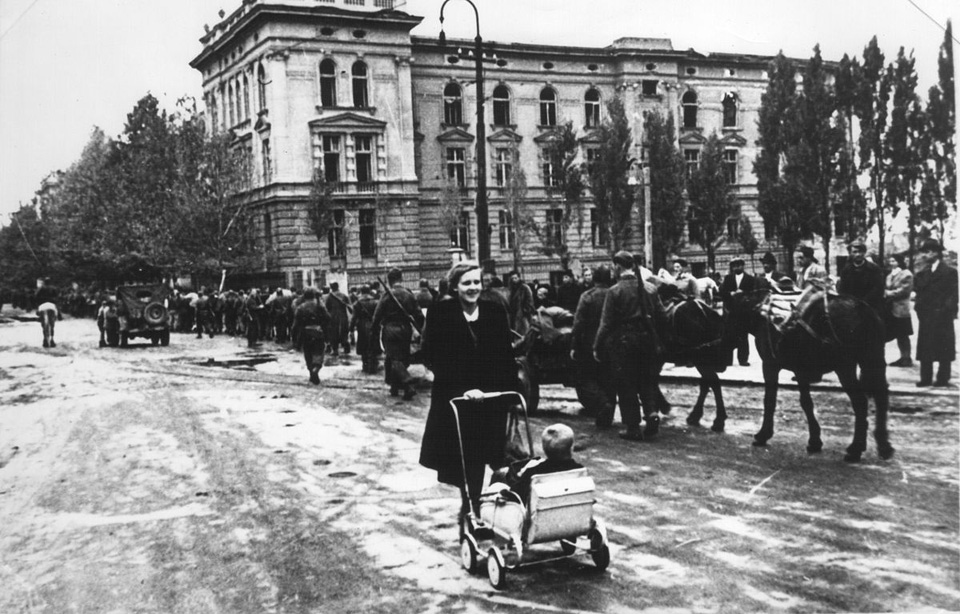 |
|
Yugoslav Partisans near Újvidék
|
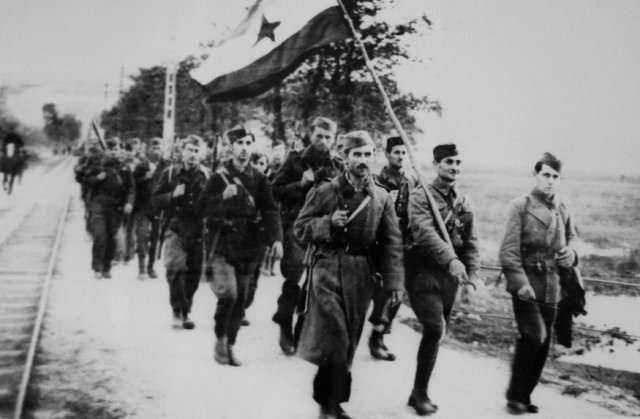 |
|
Cleaning His Rifle
|
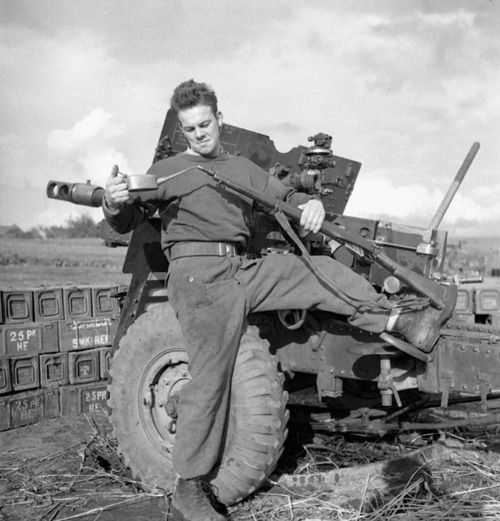 |
|
Churchill Tanks Moving Up To Attack
|
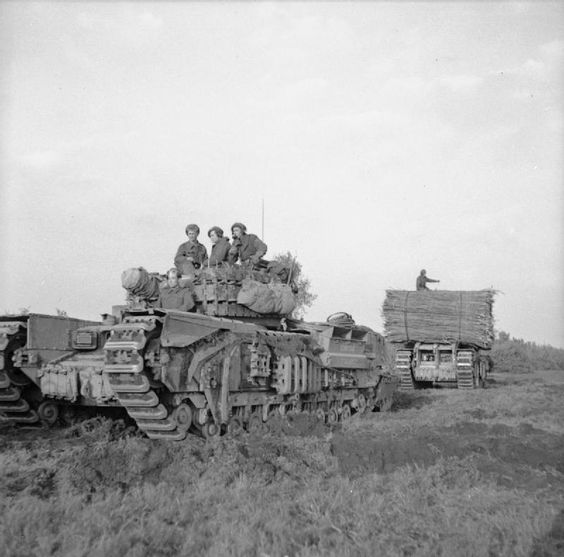 |
|
Moving Up Toward Hertogenbosch
|
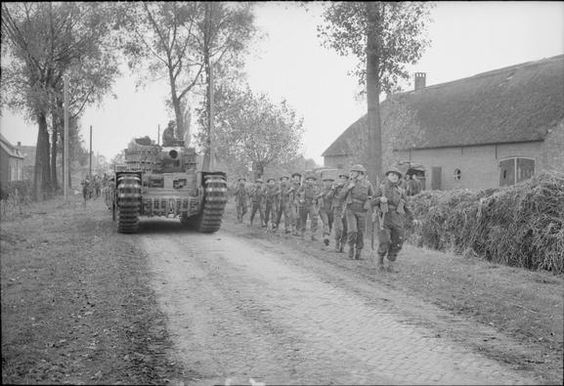 |
|
Allied Truck Convoy
|
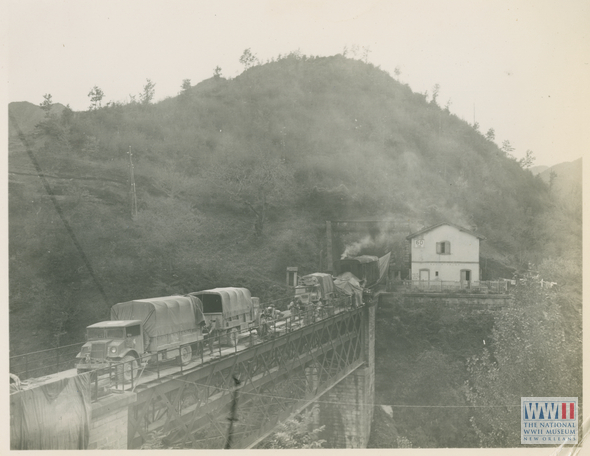 |
|
'Ram' Kangaroo Armored Personnel Carriers
|
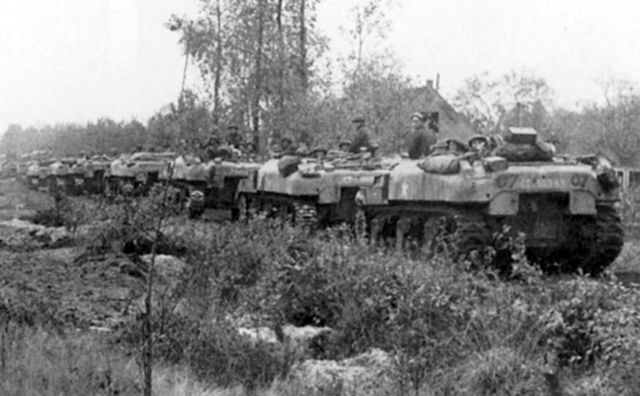 |
|
Firing Some Farms
|
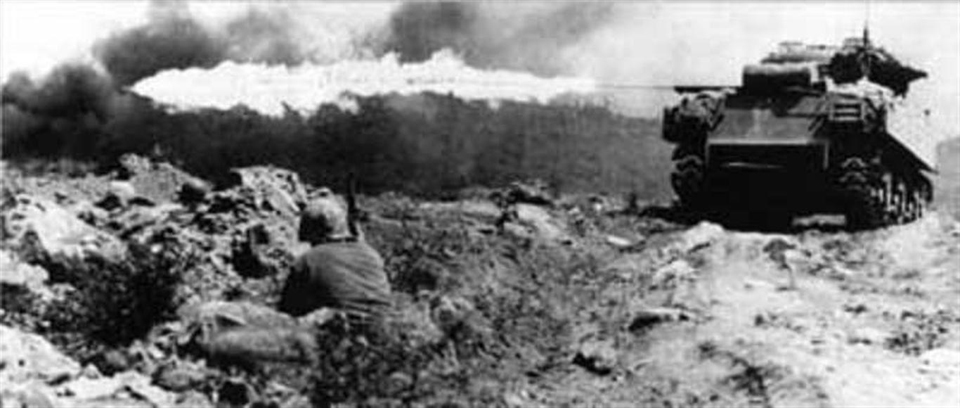 |
|
Staff Car of Lt-Gen Neumann
|
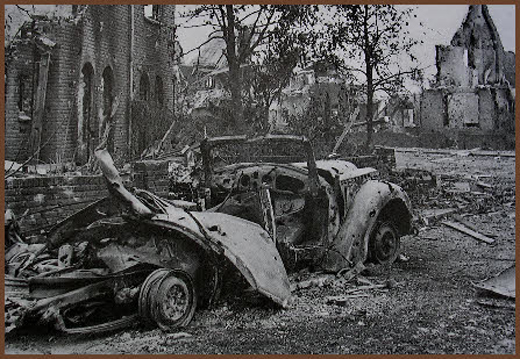 |
|
Japanese Cruiser Under Attack
|
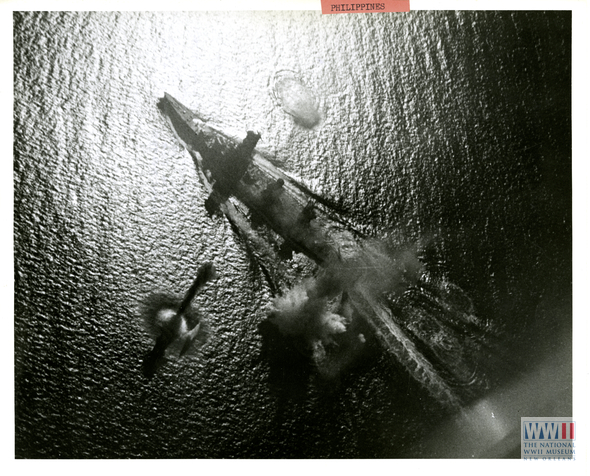 |
|
|











